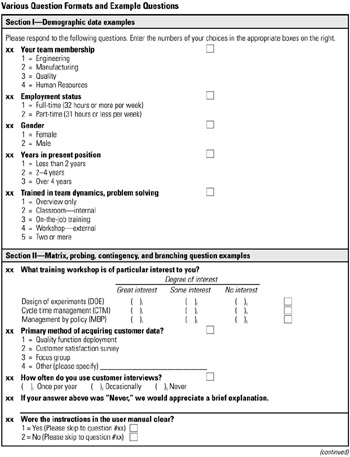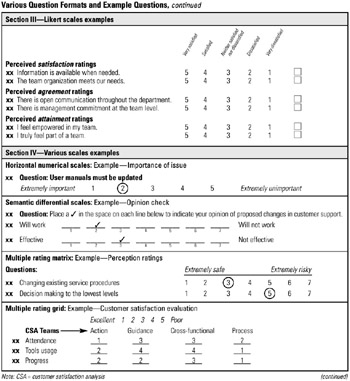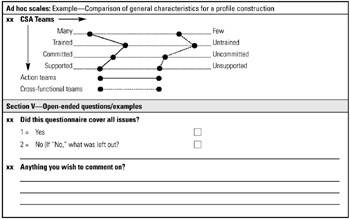Tool 156: Questionnaires
| AKA | N/A |
| Classification | Data Collecting (DC) |
Tool description
Questionnaires are useful in a data collection process that requires a large amount of data on a specific topic or problem area. The use of questionnaires is cost-effective, administratively less time consuming, and flexible for different mailing modes such as direct mail, electronic mail, or fax. Questionnaires must be carefully designed to provide valid, reliable, and unbiased response data. In order to increase the usually low response rate for mailed questionnaires, a follow-up telephone call or remailing is helpful.
Typical application
-
To complete an organizational research project that uses a self-administered questionnaire for data collection.
-
To collect specific data from a large group in a relatively short time at reasonable cost.
Problem-solving phase
| → | Select and define problem or opportunity |
| → | Identify and analyze causes or potential change |
| Develop and plan possible solutions or change | |
| Implement and evaluate solution or change | |
| Measure and report solution or change results | |
| → | Recognize and reward team efforts |
Typically used by
| 1 | Research/statistics |
| Creativity/innovation | |
| Engineering | |
| Project management | |
| Manufacturing | |
| 3 | Marketing/sales |
| Administration/documentation | |
| 4 | Servicing/support |
| 2 | Customer/quality metrics |
| 5 | Change management |
before
-
Data Collection Strategy
-
Sampling Methods
-
Demographic Analysis
-
Starbursting
-
Information Needs Analysis
after
-
Response Data Encoding Form
-
Surveying
-
Interview Technique
-
Checksheet
-
Fog Index
Notes and key points
-
Keep the questionnaire as short as possible. Only ask questions necessary for this data collection requirement.
-
Avoid open-ended responses. They are difficult to tabulate and analyze.
-
Group together questions of a particular format for easier completion and analysis.
-
Use multiple choice matrix questions for large data volume.
-
Prevent researcher bias when phrasing questions.
-
Use a panel of experts to review the draft questionnaire to check for clarity, understanding, and completeness.
-
Field-test completed questionnaires to reduce ambiguity. Use a similar group of respondents for this task.
Step-by-step procedure
-
STEP 1 As a first step, a team decides on the specific data requirements. A list of preliminary questions is developed.
-
STEP 2 The questionnaire is developed using appropriate questionnaire construction guidelines. A research text reference can be very helpful in this task. See example Various Question Formats and Example Questions.
-
STEP 3 The draft questionnaire is verified by all team participants so that the required data will be collected using the number and type of questions listed.
-
STEP 4 A small sample of the identified population of respondents is asked to assist in the field testing of the questionnaire. Final revisions are made.
-
STEP 5 On the basis of the size of the predetermined population, a sample is taken and questionnaires are mailed.
-
STEP 6 As the questionnaires are returned, the team checks the questionnaires (see response data encoding form), calculates a response rate, and decides if a follow-up mailing is needed.
Example of tool application



EAN: 2147483647
Pages: 326
- Structures, Processes and Relational Mechanisms for IT Governance
- An Emerging Strategy for E-Business IT Governance
- Measuring ROI in E-Commerce Applications: Analysis to Action
- Technical Issues Related to IT Governance Tactics: Product Metrics, Measurements and Process Control
- The Evolution of IT Governance at NB Power